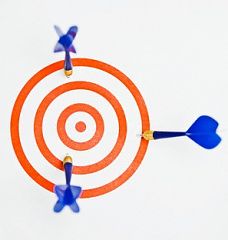Dewey 21C: August 2010 Archives
Click on through to read Advocating for Arts in the Classroom.
While I admire Bauerlein's passion, the piece had an out of touch quality to it with neat little boxes for advocates, teachers, the relationship between arts and parts of the school curriculum, and overall messaging. If only it were that simple.
The field of arts education should not be viewed solely through the lens of Arts Education Partnership meetings in 2003-2005. That being said, the people who attend AEP forums include education policy makers such as chief state school officers, district superintendents, school board members, and yes, "advocates" such as directors of education at museums and cultural organizations. But don't be fooled by the neat little boxes, as many who attend AEP and other similar conferences have regular duties and expertise in providing professional development for those who deliver instruction in the classroom, including school teachers and teaching artists.
Many of these advocates, who wear multiple hats, have been writing exemplary arts curricula that animates and extends the very standards that Bauerlein lauds. And, many of these individuals have been working hard to bring back certified arts teachers in the big cities that saw their teachers disappear bit-by-bit over a 30 year period. These very same people are on the front lines, partnering with school communities to create, grow, and sustain the arts. And, contrary to the picture painted by Bauerlein, some of these people and their organizations lead workshops on budgeting, scheduling, assessment, funding, and more, for their colleagues in the schools, including principals, teachers, and parents.
It's a big field with a lot going on.
The best part of Bauerlein's piece centers in his belief that advocacy for the arts must be based fundamentally on the arts as a discrete discipline.
If arts advocates instead emphasize the material--Shakespeare, major and minor chords, etc.--other teachers might show respect for their position, even if only to avoid appearing anti-art or anti-intellectual.And he points out that such a value is at odds with "arts ed advocates."
How to impart the importance of artistic tradition without estranging arts ed advocates?
I cannot argue with the difficulties the field writ large has had in making its case. And, the case tends to be made by hitching a wagon to anything that seems promising, whether it be 21s century skills, creativity, the imagination, the "Mozart effect," and much more. Included in this roulette wheel approach is and has always been that of art for art's sake. There are few today who do not embrace this on a basic level, even if it is communicated along with other rationale.
It's not for nothing that the field is in a continuous search for the right message: the variety of messages have not turned the tide in the big city school districts that fail to provide a quality arts education K-12. And as for placing the blame solely on what might sometimes appear to be a roulette wheel approach to validation, well, that's wishful thinking. Just ask those in all of the other (non-arts) subject areas what has happened to their place in the school day, save ELA and math. You will find that no matter what the message, the curriculum has narrowed over the past decade or longer, predominately in the big city school districts. And let's not think that the "other teachers" are the making these policy decisions, for that would simply be incorrect.
 Nevertheless, there's lots to chew on here.
Nevertheless, there's lots to chew on here.My reservations begin with the common assumption often expressed explicitly by supporters of value-added measures that the Los Angeles Times hardly revealed anything since "just about everyone in any school can tell you who the really good teachers are in the building. Whether they will tell you is another story, perhaps, but everyone knows who's good and who's bad."
As with most conferences, there was the introductory moment early on, where everyone in turn says a little something about who they are and why they are interested in the matter at hand. It's the let's go around the room and say a few words about ourselves moment.
I have never forgotten what I heard from this gentleman at the conference, one of the founding producers of Sesame Street. During his introduction, he said:
What do children need the most?I have to say, that the love part was easy, I got that. Check one for love. We love our kids and kids need love, correct? Just as The Beatles wrote: "the love you take is equal to the love you make."
Love and respect.
But, wait one second. Respect? That threw me for a bit of a loop.
 -sp
-sp kt
kt )
)Click here to read Can You Help Pay for Arts in the Schools, from the Beaverton Valley Times.
District leaders have 21 days to raise $800,000 in donations.

I asserted that a major area of opportunity was in the arena of advocacy, since there was still so much need unmet. I got a rather quick and forceful counter assertion: "oh no, advocacy is not the way to go, after all, we (the NYCDOE) cannot have CAE telling us what to to." To no avail, I pleaded that advocacy had a great deal of variety and flexibility to it, and having an outside ally as an advocate for arts education and the children of New York city public schools could be advantageous all around.
I think it would be fair to say that that particular moment was purely prescient.
Recently, a school principal who had read CAE's report on arts education spending asked me what we exactly I thought could be accomplished with the report. He added: you realize that you're going to make "the man" angry. For all those wondering what he meant by "the man," I would refer you to Cool Hand Luke, or a click through to Wikipedia.
So, why issue these reports, when the guaranteed response from the powers that be is going to lie somewhere between silence and accusations of seeking to score "press points" through the use of distorted and faulty data?
If your organization is dedicated to ensuring a quality arts education for each and every New York City public school student, and I am talking about every student, not more, the work cannot be done without creating a context around both need and positive solutions to the need. And, as an independent organization not answering to the schools chancellor or other city leaders, you really don't have to, and what is more, should not color what you write based upon how it will make what my principal colleague refers to as "the man," feel. Instead, you have to do your best in helping the readers understand what the issues are and what can be done about them. It is neither a defense of nor an offense upon the powers that be, but rather an illumination of fidelity to mission.
So, here''s a link to Teaching the Arts on The Cheap, by Cora Lewis. It was stimulated by a CAE report that falls into the category of arts education advocacy research. And yes, according to what I've read in the media, it has been received by the powers that be somewhere on the continuum between silence and discredit.
As an added bonus, you get a short piece by noted testing expert Daniel Koretz, whose work recently led to the recalibration of standardized ELA and Math test scores in New York State, which has in turn led to other such potent matters such as the evaporation of claims made by the New York City Department of Education as to its historic narrowing of the achievement gap.
Don't say I didn't warn you: you will find the article fascinating, frustrating, and a least a little bit of a headache maker.
McKnight has asked teachers to give students passages on social studies and science topics for supplemental reading lessons in preparation for the MSA. But the passages the third-graders read touched on random knowledge--Billie Holiday's alcoholism, female Arctic explorers--and breezed by quickly. They were hard to understand on the fly when the children had such little exposure, at school and at home, to history, culture, and the natural world.
Scores on the tests used for accountability have become inflated, badly overstating real gains in student performance. Some of the reported gains are entirely illusory, and others are real but grossly exaggerated. The seriousness of the problem is hard to overstate. When scores are inflated, many of the most important conclusions people base on them will be wrong, and students--and sometimes teachers--will suffer as a result.Koretz's work in particular raises some of the most remarkable questions, when you consider how the test scores have been the basis for so very much "reform," including determining the big $50 million awardees within the USDOE i3 program, bonuses for teachers and principals within merit pay programs, the closing of schools, the narrowing of the curriculum.
Is Koretz's work here new or revelatory? While it is important and timely, it is hardly new, people like Bob Tobias were raising the issue for years, in this case here is some of what Tobias reported to the New York City Council in 2005:
Standardized tests are tools designed to measure a construct. That construct may be mathematics knowledge and skill, reading achievement, or mastery of state learning standards. In our zeal to raise test scores we have forgotten that the test is a measure of learning and reified the test score to the status of learning itself. The test score has become the coin of the realm and raising scores through any means has become the Holy Grail.
...an unprecedented increase in test preparation has been widely reported, including the adoption of a new program of interim testing by the NYCDOE. Much of this test preparation is not designed to increase student learning but rather to try to beat or "game" the test. It may even serve to narrow learning by focusing instruction on the sample of content and formats used on the test rather than the broad and deep knowledge required by the standards. Thus, some of the improvement in scores may be because students have become better test takers rather than better learners.
Food for thought: arts education advocates and practitioners, think about this just a bit: if one accepts that the standardized testing regimes are so very problematic, in particular the way scores on standardized tests are conflated to measure real student achievement, how can these new developments be used as the basis to expand the curriculum rather than narrow it, in this case by rewriting the position many policy makers have taken about arts education lacking "accountability."

Apparently, Manilow not only "writes the songs" but also helps donate the instruments.
If you want to learn more about Manilow and his philanthropic work including the above, click on over to the Manilow Music Project Website.
In response to the needs of the local public schools and their severely depleted music programs, Barry Manilow gathered some friends and formed The Manilow Music Project as part of his nonprofit Manilow Health and Hope Fund. The mission statement of the Manilow Music Project highlights the importance of music programs in our schools and donates instruments and materials to school music programs.
There were approximately 1700 applications overall, 53 of which were focused on the arts Forty-nine applications were rated the highest and are now in a period of confirming the required 20 percent match from private funding (unless a waiver has been granted by the Department of Education). The match must be confirmed by September 8th.
Three of the 49 highest rated applications were arts-focused applications. So, while roughly three percent of all applications submitted were arts-focused, approximately six percent of all the highest rated applications, which are presumably heading towards final approval, are focused on the arts.
Enough with the factoids.
Here are the three arts-focused i3 applications that made the cut, a big-time congratulations to all:
1. Beaverton School District (OR) Arts For Learning Lessons Project.
Click here for the project abstract.
Click here for the review comments.
2. District 75/New York City Department of Education.
Click here for the project abstract.
Click here for the review comments.
3. Studio in a School Association.
Click here for the project abstract.
Click here for the review comments
Click here for the USDOE i3 press release.
And, here are some interesting articles about i3:
Ed Week: Interpreting i3 Scores: Good Luck.
NY Times: Education Department Deals out Big Awards (includes issue of early childhood advocates believing they were shut out of i3).
And as a promising not to all of those who didn't make it into the 49, plus others wondering about future rounds, here's an excerpt from an USDOE email last Friday:
In order to continue to support innovation and evidence-based practices, the Department will convene an event in November 2010 for other promising applicants that were not among the applicants selected. The agency plans to highlight these high-quality programs and provide them with a forum through which potential funding partners may support efforts that the Department is unable to support at this time. This list of promising applicants and the details of the event will be announced in the coming weeks.
President Obama has requested an additional $500 million in funding for the i3 program in fiscal year 2011.
And finally, in the "what did you do on your summer vacation" category, here's a photo:
The program supports the enhancement, expansion, documentation, evaluation, and dissemination of innovative, cohesive models that demonstrate effectiveness in:
- Integrating into and strengthening arts in the core elementary and middle school curricula;
- Strengthening arts instruction in those grades; and
- Improving students' academic performance, including their skills in creating, performing, and responding to the arts.

